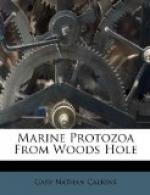Family Bodonidae:
1. Body very plastic,
Genus *_Bodo_
almost amoeboid
Body not plastic;
with large Genus *_Oxyrrhis_
anterior cavity,
holding flagella
Family Trimastigidae:
1. With an undulatory membrane
Genus Trimastix
between accessory
flagella
Without such membrane;
flagella Genus Costia
contained in a
ventral groove
while at rest
* Presence at Woods Hole indicated by asterisk.
KEY TO MARINE GENERA OF POLYMASTIGIDA.
1. Body flattened; ends rounded;
Genus Trepomonas
sides hollowed;
often with
wing-like processes;
cross
section S-shaped
2. Body pyriform; one large
Genus Tetramitus
asymmetrical groove;
4 flagella
3. Body spherical; many flagella
Genus Multicilia
equally distributed
KEY TO FAMILIES AND MARINE GENERA OF EUGLENIDA.
1. With deeply-insunk pharynx;
2
no mouth
With pharynx and distinct mouth Family Peranemidae
2. Body plastic; usually with
Family Euglenidae
chromatophores
and eye-spot
Body plastic;
no chromatophores; Family Astastidae
no eye-spot
Family Euglenidae:
Body Euglena-like,
inclosed Genus Trachelomonas
in shell with
round opening for
exit of flagellum
Family Astastidae:
Body with one flagellum Genus *_Astasia_
Family Peranemidae:
1. Body striped; plastic;
Genus Heteronema
two diverse flagella
2. Body striped; not plastic;
Genus *_Anisonema_
posterior flagellum
longer
than the other
3. Body striped; not plastic;
Genus Entosiphon
with rod-like
organ in pharynx
* Presence at Woods Hole indicated by asterisk.
Genus MASTIGAMOEBA F. E. Schultze ’75.
(Kent ’81; Buetschli ’86; Klebs ’92; Senn 1900.)
In general the form is oval and either regular in outline or irregular through the presence of many pseudopodia. One flagellum usually quite large and distinct. Differentiation of ectoplasm and endoplasm distinct or wanting. One to several contractile vacuoles. The pseudopodia are occasionally withdrawn, and the flagellum is the sole means of locomotion. In some cases the flagellum turns into a pseudopodium, and, conversely, the pseudopodium at one end may become a flagellum (see below). In some rare cases the ectoplasm secretes a gelatinous mantle. Reproduction not observed.




